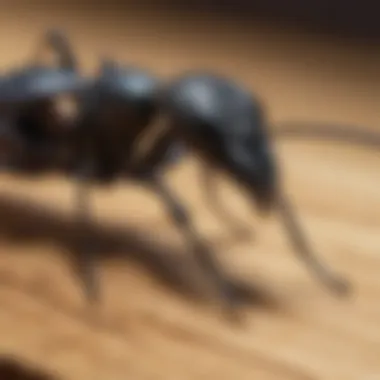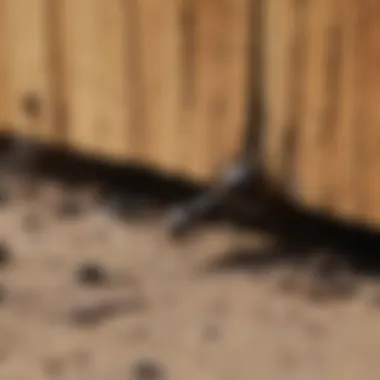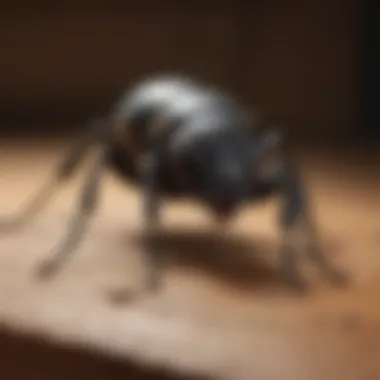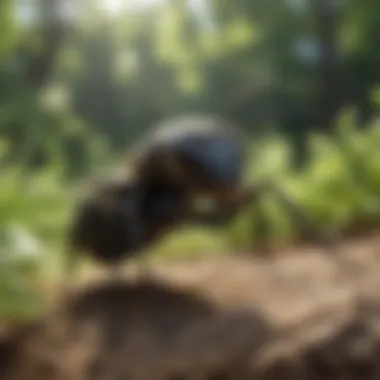Should You Hire an Exterminator for Carpenter Ants?


Intro
Carpenter ants can be a persistent nuisance for homeowners. These pests pose a risk not only to your home but also to your peace of mind. Knowing when to call an exterminator for carpenter ants is crucial. This article aims to outline the behaviors and characteristics of carpenter ants, assess the potential damage they can cause, and evaluate DIY options. By understanding these aspects, homeowners can make informed decisions about pest control strategies.
Understanding the Pest
Identification
Carpenter ants are typically black, but they can also be reddish or bicolored. They average between a quarter to half an inch and have a distinctive heart-shaped head. Knowing what to look for is vital when identifying an infestation. Look for:
- Frass: This is wood shavings mixed with ant feces, often found near nesting sites.
- Trails: Carpenter ants travel in paths to gather food and resources. Following these trails may lead to a nest.
- Winged Reproductives: In the spring, you may notice winged ants, which indicate a mature colony preparing to swarm.
Life Cycle
The life cycle of carpenter ants consists of four stages: egg, larva, pupa, and adult. Understanding this is key for control:
- Eggs: These are small, white, and laid in clusters.
- Larvae: They are white and grub-like, requiring feeding from adult ants.
- Pupae: Resembling small adult ants, this cocoon stage is found within the nest.
- Adults: Once mature, they take on roles in foraging, nursing, or defending the colony.
Pest Prevention Strategies
Environment Modification
To deter carpenter ants, modifying the environment is essential.
- Remove Food Sources: Keep food sealed and minimize crumbs.
- Eliminate Moisture: Carpenter ants are attracted to damp wood. Fix leaks and ensure proper drainage around the home.
- Inspect Landscape: Trim trees and shrubs so they do not touch the house, reducing ant pathways.
Physical Barriers
Creating physical obstructions can enhance prevention:
- Seal Cracks and Crevices: Use caulk to close gaps around windows and doors.
- Install Screens: Proper screens can keep flying ants out.
Control Methods
Chemical Control
If an infestation is confirmed, using chemical control may be necessary:
- Insecticide Sprays: These can be effective but must be applied carefully to not harm non-target species.
- Baits: Carpenter ants are attracted to sweet and protein-rich baits, which can help in targeting them efficiently.
Biological Control
Biological methods may include:
- Predators: Encouraging beneficial pests that prey on carpenter ants can help keep their population in check.
- Nematodes: These microscopic worms can be introduced to the soil; they infect and kill ants.
It is always wise to thoroughly evaluate the infestation and consider professional help if the situation seems dire.
Understanding Carpenter Ants
Understanding carpenter ants is crucial when deciding how to handle an infestation. Carpenter ants, known scientifically as Camponotus, are large black ants that form nests in wood, which is essential for their life cycle. Recognizing their biology, behaviors, and the signs of an infestation can help homeowners make informed decisions regarding pest control. By grasping these specific elements, individuals can better assess the gravity of the situation and the potential need for professional extermination services. This section highlights the importance of early detection and understanding of carpenter ants, ensuring that proactive measures can be taken before the problem escalates.
Biology and Life Cycle
Carpenter ants undergo a complete metamorphosis, consisting of four stages: egg, larva, pupa, and adult. The colony starts with a fertilized queen, who lays eggs. The larvae feed on various organic materials, including wood, aiding in the expansion of their colony. Unlike termites, carpenter ants do not eat wood; instead, they excavate it to create nests. Their life cycle can take anywhere from a few months to several years, depending on environmental conditions and food availability. Typically, these ants prefer moist wood, making water-damaged areas ideal for nesting. Knowing the life cycle can help homeowners identify when infestations are likely to grow.
Behavioral Patterns
Carpenter ants exhibit nocturnal activity, often foraging for food at night. They are social insects that communicate with each other through pheromones. Nesting patterns vary; some colonies may build their homes in trees, while others choose structures such as buildings where they can cause significant harm. They tend to create tunnels and galleries within wood, which can compromise structural integrity over time. Carpenter ants are not aggressive unless provoked, but their presence indicates that a problem exists, and they may attract other pests. Understanding their behavior allows homeowners to observe signs of infestation more effectively.


Signs of Infestation
Detecting signs of carpenter ant infestation is essential for taking timely action. Homeowners should look for:
- Sawdust-like particles: These resdue or frass often accumulates near wood or in pathways.
- Rustling noises: Sounds may come from within walls or ceilings, indicating activity within a nest.
- Increased ant activity: Noticing large black ants inside or outside the home is a key indicator.
- Wood damage: Hollow-sounding wood or visible tunnels are signs of where the ants have excavated.
Early detection of carpenter ant presence is vital to preventing substantial damage.
Recognizing these signs early can mitigate potential damage and inform whether intervention, whether DIY or professional, is necessary. By understanding the biology, behavior, and signs of carpenter ants, homeowners are empowered to take action swiftly.
Assessing Damage Potential
Assessing damage potential in the context of carpenter ants is essential. The evaluation helps homeowners understand the risks involved with an infestation and to determine if specialist help is necessary. Carpenter ants can inflict significant harm to wooden structures, leading to costly repairs. Recognizing the signs and extent of damage can protect your investment and maintain the integrity of your home.
Impact on Structures
Carpenter ants create nests by hollowing out wood, which can lead to serious structural issues if not addressed. They prefer moist, decaying wood but can also infest sound wood. Given their preference for wood, carpenter ants do not eat the wood but rather remove it to make their nests. This behavior poses a threat to homes, especially within beams, walls, and floors.
Signs of structural damage may include:
- Hollow-sounding wood when tapped
- Frass, or wood shavings near entry points
- Cracked or distorted wood
Repairing structural damage can become costly, and the effort required can escalate if the infestation is not managed promptly. Regular inspection is crucial to identify early signs of damage and allow for timely action.
Health Risks Associated
While carpenter ants are not known to transmit diseases like some pests, their presence can still indirectly bring health concerns. When they infest a structure, they often coexist with other pests that might carry pathogens. Additionally, carpenter ants can become a source of allergen for sensitive individuals. This exposure, although less direct, creates a situation that could pose health risks over time.
Moreover, if the structural damage caused by these pests becomes severe, it may lead to unsafe living conditions. People living in compromised structures might face dangers such as collapsing floors or unstable walls.
Criteria for Professional Intervention
Choosing to call an exterminator is not a decision to be taken lightly. It involves various factors that must be carefully weighed against the specifics of the infestation in question. Factors like the extent of the infestation, the location of the nest, and any previous pest control attempts are crucial in determining the best course of action. By assessing these elements, homeowners can make informed choices tailored to their unique situations.
Extent of Infestation
Understanding how widespread the carpenter ant problem is within your home is key. A few ants spotted here and there might not warrant professional help, but larger numbers indicate a potentially serious issue.
If you notice carpenter ants roaming around or actively nesting, take note of the numbers. A small colony may be manageable with DIY methods, but an extensive infestation can threaten structural integrity. It is advisable to conduct a thorough inspection to determine how many ants you are encountering. Key signs of a bigger problem include:
- Trails of ants leading to and from food sources or nest sites.
- Presence of frass, which is a residue left behind by carpenter ants and looks like sawdust.
- Multiple sightings of ants in various areas of the house.
In situations where your inspection reveals a larger infestation, seeking professional extermination services can be more effective than anything a homeowner can manage alone.
Location of the Nest
The location of the nest influences whether an exterminator should be contacted. Carpenter ant nests can be found in wood both inside and outside the home. Common nesting locations include:
- In decayed or damp wood within walls, attics, and basements.
- Near structural beams and wooden supports.
- Inside tree stumps, wood piles, or landscaping materials outside.
Finding the nest can be challenging. If the nest is located in a hard-to-reach area or inside a wall, DIY methods may fall short. Here, professional exterminators utilize specialized tools to access and eradicate nests efficiently.
Previous Pest Control Attempts
Another important consideration is whether there have been any previous attempts to control the carpenter ant issue. If amateur methods or over-the-counter products have been used without success, it may indicate a more significant problem requiring experience and expertise. Using the wrong treatment can exacerbate the situation, causing ants to scatter and establish additional nests.
Reflect on the following questions:
- Have you tried bait traps, sprays, or other DIY solutions?
- Have those methods failed to yield results over a reasonable time?
- Are you still seeing carpenter ants after treatment?
If the answer to these questions indicates ineffective outcomes, professional intervention may be essential.


Contacting an exterminator can save time and prevent further damage when the ant problem escalates beyond manageable levels.
Assessing these criteria methodically leads towards a more informed decision. The interplay between the extent of infestation, nest location, and previous control attempts all highlight the need for professional intervention. This careful analysis can determine whether your carpenter ant problem can be handled alone or if the expertise of an exterminator is required.
DIY Pest Control Options
When dealing with carpenter ants, DIY pest control options can provide a critical first line of defense. Homeowners often appreciate the affordability and personal involvement that come with taking control of their pest problems. Understanding how to effectively monitor for ants, as well as employing natural remedies or home treatment methods, can reduce the need for professional extermination. This section discusses practical strategies that can assist in managing carpenter ant infestations before considering an exterminator.
Identification and Monitoring
The first step in any pest control strategy is accurate identification and diligent monitoring. It is essential to distinguish carpenter ants from other ant species, as their behavior and nesting habits differ significantly. Carpenter ants are typically large, with a black or red coloration, and are known for their ability to excavate wood, creating smooth tunnels.
Regular checks of your property can aid in early detection. Look for:
- Visible ants: Observe their movement; carpenter ants usually forage at night.
- Wood shavings: Examine areas around wooden structures for signs of excavated wood.
- Frass: This material, resembling sawdust, is a sign of an active nest.
By placing sticky traps near suspected nests, homeowners can monitor the ant population. If you find that the pest has spread significantly, it might be time to escalate your efforts.
Natural Remedies
Homeowners who prefer eco-friendly approaches to pest control can turn to various natural remedies. Many everyday household items can deter carpenter ants without the need for potent chemicals. Some effective natural options include:
- Vinegar: A simple mixture of equal parts vinegar and water can disrupt the scent trails ants use.
- Essential Oils: Peppermint or tea tree oil can be diluted in water and sprayed around entry points to repel ants.
- Boiling water: Pouring hot water directly onto nests or ant trails can be an immediate solution.
Natural remedies are often safer for children and pets while still providing some level of control. Yet, they may require consistent application for best results.
Home Treatment Methods
If natural remedies do not yield adequate results, homeowners might consider more robust home treatment methods. There are two main types of treatments:
- Bait Stations: These contain a slow-acting poison that ants carry back to their nest, targeting the queen and other colony members. Place bait stations near active ant trails for effective results.
- Insecticidal Dust: This form of treatment can be applied to cracks, crevices, or nest sites. Dusts such as diatomaceous earth act to dehydrate ants upon contact. Proper application is crucial for effective results.
In addition to these methods, maintaining cleanliness in your home can prevent further infestations. Regularly removing food scraps and sealing up pantry items can minimize attractants.
"Vigilance and timely intervention can make all the difference in managing carpenter ants effectively before needing external help."
By applying these DIY pest control options, homeowners can assert control over carpenter ant populations while considering their long-term management strategies.
Preventative Measures
Understanding how to prevent carpenter ant infestations is crucial for every homeowner. This section will address various strategies that can help in minimizing the risk of an ant invasion. Preventative measures not only safeguard your property but also contribute to maintaining a healthy living environment. By implementing smart practices, homeowners can reduce the chances of these pests making their homes invincible.
Seal Entry Points
Sealing entry points is fundamental in controlling carpenter ant populations. These pests can enter your home through even the smallest openings. Inspect the exterior of your house for gaps around windows, doors, and utility pipes. Use caulk or weather stripping to fill these spaces effectively. Pay particular attention to areas where wood comes into contact with soil; untreated wood is a favorite for carpenter ants.
- Check for cracks and openings around foundations.
- Secure entry doors and windows with proper fitting.
- Seal holes created by utility installations.
Ensuring these entry points are sealed not only reduces the chances of infestation but also enhances energy efficiency in your home.
Removing Food Sources
Another significant approach is removing food sources that attract carpenter ants. Make it challenging for them to find what they need to thrive. Regularly clean areas where crumbs or spills may accumulate, including under appliances. Store food in sealed containers, including pet food, to minimize odors that could draw in these pests.
- Clean spills immediately to avoid attracting them.
- Store grains and other edibles in airtight containers.
- Dispose of trash regularly, keeping lids tightly closed.
By eliminating potential food sources, homeowners can significantly discourage ants from seeking shelter and nutrition inside the home.
Landscape Management
Effective landscape management plays an essential role in deterrence. It's important to keep the area around your home tidy and well-maintained, as overgrown vegetation can provide shelter for carpenter ants. Trim trees and bushes that touch the house, since they can create direct pathways for these pests.


- Keep mulch and organic debris away from the foundation.
- Ensure proper drainage around the property to prevent damp areas.
- Regularly trim trees and shrubs that are too close to the home.
A well-maintained landscape significantly reduces the likelihood of infestations and promotes a healthier environment overall.
Choosing an Exterminator
When it comes to addressing a carpenter ant infestation, deciding whether to hire a professional exterminator is a significant choice. The presence of carpenter ants in your home can lead to structural damage and may compromise your living conditions. Therefore, professional intervention may ensure that the problem is effectively managed.
Engaging an exterminator brings several advantages. First, these professionals have specialized training and experience that can provide a comprehensive assessment of the situation. They can identify the infestation's source and develop a tailored treatment plan. Homeowners may lack the knowledge of where these ants are coming from or how to eliminate them effectively.
Moreover, a qualified exterminator utilizes advanced techniques and tools that are often beyond the capability of standard DIY methods. This professional experience may not only bring relief but also ensure a long-term resolution by tackling not just the visible ants, but also the nests hidden within walls or other discrete areas of the home.
Evaluating Qualifications
When choosing an exterminator, evaluating their qualifications is crucial. Licensed pest control specialists have met specific regulatory requirements, which can vary by location. The first step is to verify whether the company holds a valid pest control license. This demonstrates a level of professionalism and adherence to safety standards.
In addition to licensing, assess their experience within the industry. Companies that have been operational for several years often have a proven track record. Check for reviews and testimonials from previous clients. Positive feedback can indicate their reliability and effectiveness. You can also inquire about the certification of the exterminators who will work on your property. Certification often requires additional training, showcasing their knowledge of current best practices in pest control.
Assessing Treatment Methods
Once qualifications are confirmed, the next step is to understand the treatment methods used by the exterminator. Not all exterminators will adopt the same approach, so clarity on their procedures is essential. Inquire about their strategies for controlling carpenter ants, including baiting systems, insecticides, and exclusion tactics.
Some exterminators may emphasize eco-friendly practices, which may be important if you prefer a more natural approach. Understanding their methodology gives insight into how thorough and effective their treatment may be. A good pest control provider will tailor their methods based on the specific infestation and home environment. It is advisable to request a detailed explanation of the proposed plan before signing any agreements.
Cost Considerations
Cost is another key element when deciding on an exterminator. Prices can vary significantly depending on several factors. To begin with, the severity of the infestation will directly influence the treatment costs. More extensive infestations usually demand higher investments for proper remediation. Also, geographic location can play a role in pricing structures.
Requesting quotes from multiple exterminators can provide a clearer idea of prevailing rates in your area. However, while cost is an important consideration, it should not be the sole deciding factor. Cheaper options may not always provide the quality service needed to resolve serious problems.
Long-Term Management Strategies
Effective management of carpenter ants extends beyond initial pest control efforts. It necessitates a commitment to ongoing monitoring and proactive measures. The significance of these strategies lies not only in addressing immediate infestations but also in reducing the risk of future problems.
Monitoring and Follow-Up
Monitoring is a vital component of long-term management for carpenter ants. After addressing an infestation, it is essential to keep a close watch on your home. Regular inspections can help identify any signs of returning ants. Look for droppings, frass, or worker ants foraging in the vicinity of your property. Setting up bait stations can assist in tracking ant movement without much disruption to your daily life. This step allows you to catch a potential re-infestation early, making solutions more manageable.
Follow-up measures should include periodic checks, ideally at least once a month during the warmer months when ants are more active. Documenting any findings can help in pattern recognition and detection of new activity, ensuring that you stay one step ahead of these pests.
Incorporating Eco-Friendly Practices
As concerns over chemical usage grow, eco-friendly management practices offer sustainable alternatives. Using non-toxic baits or natural deterrents can reduce exposure to harmful substances for your family and pets.
Some methods include:
- Diatomaceous Earth: This is a natural powder that can be spread in areas where ants are likely to travel. It is safe for humans and pets but lethal to ants.
- Essential Oils: Oils like peppermint or tea tree can act as natural deterrents. They can be mixed with water and sprayed in areas known for ant activity.
- Boric Acid: It is often recognized for its effectiveness against ants. When used carefully, it can provide a balance between pest control and environmental safety.
Using these methods not only helps in managing carpenter ants but also supports a healthier living space. Addressing pest issues with eco-friendly strategies ensures sustainability for your home and the surrounding environment.
In summary, engaging in proactive monitoring and adopting eco-friendly practices creates a safer and more effective long-term strategy in managing carpenter ants.
Establishing these practices can save time and resources, ultimately leading to a more durable solution. Making conscientious choices regarding pest management can protect your home and contribute to environmental preservation.
The End
Understanding the decision of whether to call an exterminator for carpenter ants is crucial for homeowners and housewives alike. This section synthesizes the essential aspects discussed throughout the article, providing clarity as the final step in tackling a potential infestation.
Making an Informed Decision
When dealing with carpenter ants, the choice to call a professional can shape your response to the problem. Several factors come into play that can make this choice straightforward or complex. First, assessing the scale of the infestation is paramount. A small group of ants may not require immediate professional intervention, whereas a serious invasion often necessitates expert help.
Next, the location of the nest can influence your decision. If the nest is hidden within walls or underground, it can be challenging to manage effectively without specialized tools and knowledge. In such cases, the expertise of an exterminator can provide a significant advantage.
Furthermore, reflect on your past experiences with pest control. If previous attempts to remove carpenter ants have failed, this may highlight the need for professional assistance. An understanding of the biology and behaviors of carpenter ants, as outlined in earlier sections, will aid in making informed choices.
In summary, weighing these factors helps in making a prudent decision. Pros and cons should be weighed carefully. Informed decisions can lead to effective solutions, minimizing damage to the home and ensuring peace of mind.







